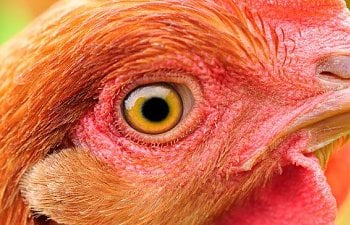Chicken eyesight is amazing! They can see better in color than humans, can detect and see light and color shades better than humans, have three eyelids, can move each eye independently, and have a 300-degree field of vision without turning their head.
How Chickens See
Although their eyes are on the sides of their heads, chickens see the same way we do. Wavelengths of light come in through the cornea and iris and then stimulate nerve endings in the retina at the back of the eyeball. One of the big differences, however, is that chickens have 4 types of cones so they have tetra-chromatic vision, while we have tri-chromatic. Chickens have four wavelengths (blue, red, green, and ultraviolet light) while we can only have three (blue, red, and green.)Chickens’ color vision is different from ours because they have colored filters mixed with nerve cells. They are like little oil droplets filtering out different wavelengths and act similarly to wearing yellow goggles when skiing.
The fact that chickens see an extra sector of the light spectrum means that everything they see looks different from what we see. We have no description or idea of how much ultraviolet light is reflected from any substance. Chickens also have better motion-sensing ability than we do. This is good to know if you use or plan on using artificial lights or fluorescent lighting in your coop. These lights flicker on and off at a rate above what we can see. This is very annoying to your flock and may cause them to start bullying each other.
Birds as well as other mammals have a structure called a fovea in their retinas. It basically is a small pit that, because of its shape, acts as an image enlarger. Chickens have two foveae, which act a little differently. One is for distant vision, and one is for close-up vision. The interesting thing is that the up close one is oval and sideways and that’s why, when you approach your chicken, they will often bob their heads and tilt their heads sideways to get the image of you into a clearer view. Shockingly, chickens actually can’t really recognize flock members until they are within about 24 inches.
Now don’t go drawing any conclusions that chickens are the best-seeing creatures on the planet! Chickens, like humans and other animals, have poor night vision and are blind in the absence of light. We need color and/or light to see so when there is no light we cannot see. Chickens, however, are blind when it is not completely dark such as after dusk. Regarding this issue, since chickens are like zombies at night, it makes them highly susceptible to predators. (See below for links on predators.)
The Third Eyelid
Sometimes when we take a picture of our chicken we see that the chicken’s eye is hazy-looking. At first glance this looks like a glitch in the camera but actually, this is the chicken’s third eyelid called the nictating membrane. The nictating membrane is positioned next to the eyeball, underneath its other two eyelids, and works independently from them. It operates by sliding from the front to the back of the eye. It has two purposes: cleaning and protecting.
When a chicken takes a dirt bath, you will see the nictating membrane appear. This is because it is protecting the eye from dirt and dust entry. Another time you may see it appear is when your flock is sleeping. They sometimes don’t close their eyes completely and thus, the nictating membrane covers the eye instead.
How Chickens Use Their Sight
Chickens, obviously, use their eyes all day every day. They use their color vision to find bugs and other insects. They use their light vision to keep track of the daytime and use it to help them know when to go back to the roost. They use their motion-sensing ability to watch for predators, keep track of each other and, again, find food.The mother hen uses her color vision to see which chicks are the healthiest. She uses her wavelengths of UV light (ultra-violet light) to see the chicks’ feathers. If they have shiny feathers, this means that they are healthy and thus have a higher chance of survival.
Before chicks hatch, they turn in the shell so that their right eye is next to the shell and their body covers the left eye. Once they hatch their right eye develops near-sightedness, which allows them to search for food, while the left eye develops far-sightedness, allowing them to search for predators from afar. That is why when a bird of prey flies overhead, chickens tilt their heads with their left eye up to the sky.
Conclusion
Chickens have truly amazing, keen, and sharp eyesight. We don't know everything about their eyes or how they work. But as long we continue to be fascinated by chickens, the longer we will continue to learn about them and their visual systems.Helpful Sources
http://mikethechickenvet.wordpress.com/2012/03/30/chicken-vision/http://www.the-chicken-chick.com/2013/05/chicken-anatomy-nictitating-membrane.html
http://www.fresh-eggs-daily.com/2013/10/do-you-see-what-i-see-12-fascinating.html
https://www.backyardchickens.com/a/chicken-predators-pests-how-to-protect-treat-your-flock
https://www.backyardchickens.com/atype/2/Coop_Designs

